Therefore, I'm presenting a personal project: a retrofit of a late-1960s era cabinet record player. It's a Fleetwood model 4057, made in Montreal, serial 283. It came complete with AM and shortwave radio, record player and tape input, powered by a tube amp rated for 117 V, 0.95 A at the input. I believe these units were retailed by Sears. The guts were all removed and replaced by a modern turntable, digital music player, amplifier and controller.

Before the retrofit, the unit lights and tubes lit up. On radio, it crackled when you adjusted the volume but couldn't be tuned to any station. The record player wouldn't rotate and no sound was produced when the record was turned by hand. So the radio/amp was removed and sent to the tube amp hospital and the record player went to the morgue.

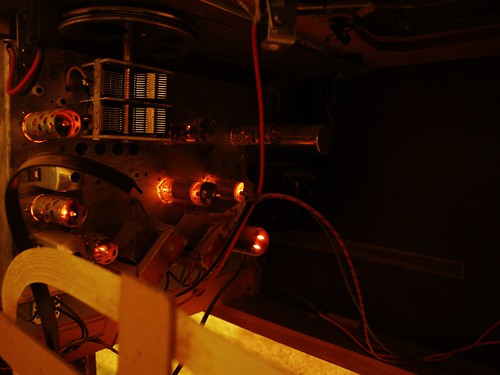
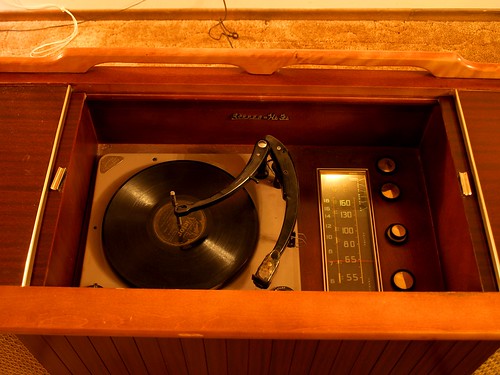
The first step in the retrofit was to replace the record player shelf as it had a large cutout for the sunken turntable. I took this opportunity to add some vibration isolation. I expected structural feedback to be a significant problem because the speakers and turntable are mounted in the same unit, as opposed to satellite speakers. Thus, the turntable shelf was designed to be a massive vibration isolator. The shelf is constructed of a wood frame with hardboard top and bottom panels, filled with sand.

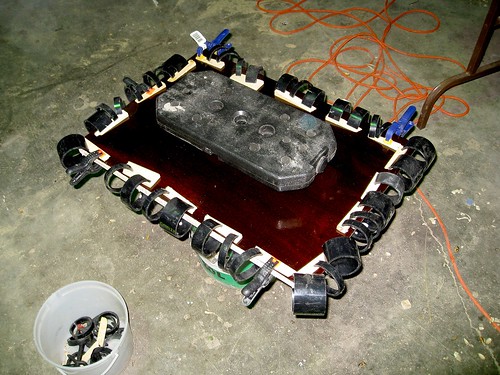
The turntable was replaced with a Stanton T.80 turntable, capable of digital S/PDIF output.
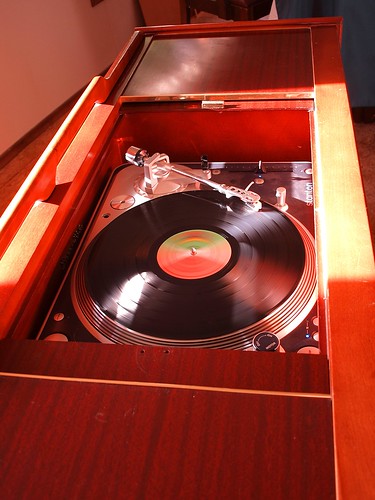
Next: digital music. Digital music is played by a VIA Epia M10000 mainboard. This is a small form-factor (Mini-ITX) low-power computer. It's a bit underpowered for video, but is perfect for a mp3 and internet radio player. I've installed Ubuntu server and use VLC as a media player, controlled either over SSH or with its web interface.

The amplifier is an older Sony, purchased second hand for cheap. It sits in the centre cabinet. The computer provides one analog input and the turntable provides a digital input. The integrated speakers mean that the speaker cables need not be flexible after installation, so I used solid 12-gauge residential electrical cable ($1/foot at Rona for essentially no resistance and no chance of phase distortion from complex impedance). The original speakers (12-inch woofer and tweeter) haven't been replaced yet (and may not be).
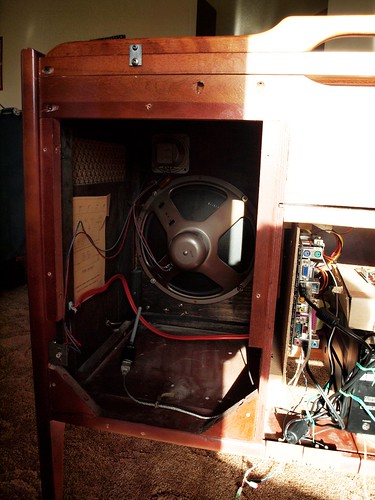

Since the amp is mounted in the belly of the cabinet, the remote no longer works. I worked around this by using a microcontroller to relay the IR remote signals. There is an IR sensor behind the cloth of the right speaker, which is processed by an ATMEGA168 microcontroller. Signals destined for the amplifier (Master Volume, etc) are repeated on an IR LED temporarily taped to the amplifer's remote input. Signals that target the digital music player (track forward, etc) will be passed to the computer over USB (this functionality is not done yet). The USB link will also allow one to control the amplifier over the network. A preamp and mixer will use digital pots driven by the microcontroller to adjust the relative levels and tone of the turntable, digital music player and an aux input. This function is not yet operational, but I can dim three leds using the remote. All of this is being prototyped on an Arduino board since it has USB connectivity and there is a nice library of IR remote functions (written by Ken Shirriff).

So how does it sound? I haven't done any acoustic analysis yet and I hate audiophile-style subjective reviews, but, to my ears, it sounds really good, especially considering the vintage speakers. There is no discernible distortion at normal listening levels (as long as I remember to set the soundcard gains to avoid digital clipping).
Unfortunately, my massive sound isolator is not super effective. At high gains there is a 94.1 Hz feedback that can be eliminated if I put all my weight on the cabinet. This frequency corresponds to a 10.6 ms delay (assuming there is no signal phase changes) which at a sonic speed through wood of 3300 m/s would require a signal path of 35 m, clearly much longer than the size of the console. This leads me to believe there is a significant delay in the turntable's analog to digital conversion process. Perhaps switching to the analog output (with presumably no delay) will solve this problem, although it may just move it to a higher frequency. Alternately, the solution may be to reduce the coupling between the cabinet and the turntable shelf. The shelf is a relatively tight fit so the effective spring between the console and the shelf is relatively stiff. I plan to modify the shelf mounting so that it has no solid contact with the cabinet, being suspended on acoustic foam or a semi-liquid like acoustic caulk or Blutack.

Next: performance characterization and speaker optimization.
Edit 20/09/2009: I almost forgot to mention that I plan to host a session on microcontrollers at Bar Camp Saskatoon.

19 comments:
I love the old Cabinet! Beautiful wood!:) Back in about 1979, I refinished an old late 50's early 60's HiFi Cabinet. I was a Cabinet Maker at the time so this was right up my alley. I made the Turntable Pull out into a Cassette Holder. Cassettes were the current music format at the time. I put my Teac Cassette Recorder - Player in it with switches for my 4 Stereo Speakers (to turn them on and off), which I had mounted on the Walls through out my home. Originally, it was only a Mono Unit so it was not big enough to hold my Receiver - Turntable. So, I just set it on the top of the Cabinet. This worked out well since my Cabinet opened up with two doors in the front and the top was solid. It was made of Oak Plywood, with solid Oak Trim. It was a light color originally and I didn't like that at the time. So, I sanded it down and stained it with American Cherry, my favorite color to this day. I removed the Speaker and Cloth from the bottom of the Cabinet and made some Sliding Doors for that area and used the space as storage. I used it for many years, until I gave it to a friend. Minus the Stereo equipment;) He had a better setup than my old stuff anyway. By that time, the early 90's, We were both doing sound for Concerts. And he had some Small 150 Wat EV Cabs and a 1000 watt Crown Amp that we used in the house, wired directly to his 5 disk CD Player which sounded great and didn't even need an EQ (when not in use on a job). Well, Ok... So later on, I couldn't resist hooking up the Mackie Mixer and some mikes so I could practice singing too;) Then we could hook up guitars keyboards, what ever we wanted... Those EV's literally Rocked the House!;)
You really know your Audio! Great work!:) I wonder if it would be easier and work better, if you built or bought some speaker boxes and probably some newer speaker drivers to just set inside of the openings in the cabinet. You could set them on something that dampens the vibrations and maybe put something on the walls of the Cabinet too to isolate the Speaker Cabs from the Cabinet. I like the old speaker drivers too though, they usually have such a warm sound. You might try mounting them in the Speaker Boxes, if they would fit. I'm thinking, that since they are presently mounted directly to your cabined. There is a certain amount of vibration being transfered directly to the rest of the Cabinet that cannot be stopped by Dampening or Insulating the Walls or by Isolating the Turntable alone. Just one Idea...
I love to window shop on this site and use to resale though them too. I still get a little bit of a discount off of their retail prices. Don't worry I'm not trying to sell you here. Just thought you might like this site, if you don't already know about it...
http://www.parts-express.com/home-audio-video.cfm
Here's some great little Speakers, Dayton, that don't cost allot and sound great. I bought a set like this for a friend several years ago and they sound great, are very clean and that Sub can Rock the walls of his Apartment too!:) Dayton HTP-1 5.1 Home Theater Package 8" Powered Subwoofer...
http://www.parts-express.com/pe/showdetl.cfm?Partnumber=300-692
Here's the rest of their Surround Systems...
http://www.parts-express.com/wizards/searchResults.cfm?srchExt=CAT&srchCat=766
Dayton B652 6-1/2" 2-Way Bookshelf Speaker Pair. These might be ok for the job. They are on sale now for $29.00 PR Sku 300-652: http://www.parts-express.com/pe/showdetl.cfm?Partnumber=300-652
Although I would want some nice JBL, EV or Eminence Drivers, if I could afford them... heck the last time I heard a new Peavey setup, they sounded darn good too.
http://www.parts-express.com/wizards/searchResults.cfm?srchExt=CAT&srchCat=582
Speaker Building...
http://www.parts-express.com/speaker-building.cfm
Pro Audio...
http://www.parts-express.com/pro-sound.cfm
Well, guess I've thrown enough at you on this... I just love the idea of restoring old Wood and Stereos!:)
Don
Have you looked into Neoprene padding? I've had good results using neoprene pads or mats that cover approximately 15-30 % of the contact area (usually four 1" squares on a piece not much larger than two square feet total) for vibration isolation at 60 Hz and above.
Although I hate to suggest rebuilding the record player shelf, using the Masonite with thin strips of neoprene, maybe 1/8" thick where you currently have the bits of 1 by (unless my eyes fail me, and you have some other dimension serving as you rails and stiles on that shelf between the sand) but keeping the sand for any lower frequencies you're concerned about?
It's a beautiful project regardless, and the remote fix is significantly more elegant that what I would have come up with. Kudos, sir.
-BFJD
Don,
I had considered using a suspended speaker box inside the cabinet speaker box. However, if you look at the speaker interior pics, you can probably see that the drivers' flanges are right up against the cabinet walls. Meaning I'd have to replace the drivers with smaller ones.
BFJD,
Good idea about the neoprene mats. I assume you mean to put them between the shelf and the turntable's feet. Unfortunately, there is about 1 mm of space between the top of the turntable and the sliding top doors, so I can't lift it any more.
I think your idea about using a neoprene spacer instead of the wood might work but would require a bit more extensive rebuild and analysis. The top plate of the shelf is the one that fits into the groove of the cabinet (again due to the limited headroom) with the massive shelf hanging from it. So if you put a springy layer between the top shelf and the the bottom, you'd be effectively separating the turntable from the mass by a spring (rather than the intended hard coupling between the mass and turntable with a damped spring between the mass and the cabinet). That might work, but would behave as a hard-to-tune tuned mass damper.
Instead, I'm considering cutting the rails off and supporting the entire shelf on blocks from below, with a springy/damping material between the shelf and cabinet.
Very cool project! Love it. About those original speakers, I know many of these older consoles had German made alnico drivers (Grundig, Saba, Isophon, etc.) that are very highly regarded. I'm curious what model yours has.
I've got no idea what kind of speakers they are. No manufacturer marks, just cryptic numbers.
Excellent idea! I'm in the middle of doing a similar thing with an old stand-up radio console for my girlfriend... Might I suggest trying MPD as your media player? It takes a bit of configuring to get working, but it has so many frontends/clients it's sickening. I was able to giver her a web interface, an iTunes-like client for her Mac called Theremin, a little playlist/visualization display on the actual radio using ncmpcpp, a client for her iPhone AND a client for my Droid. Check MPD's wiki, it really rocks. http://mpd.wikia.com/wiki/Clients
MPD looks perfect.
I actually came here to suggest the exact same thing as the other Sean, use MPD and install a client on other systems. I have an old AMD Athlon XP in my room for the same thing, and it is also running the Deluge Daemon (a client/server torrent app) and I connect to it with the Deluge Client on my Windows box
Also, good to see some Kiwi ingenuity on the web!
MPD is up and running. Having a bit of trouble getting Ampache going, but I've got a client that runs well over SSH.
These kinds of rigs really get attention, especially when you don't alter the exterior in any way. I did the same thing with an old cabinet, only it's running Windows XP and a free jukebox program. I also decided to alter the look of the cabinet to give it a more arcade look. I would certainly do this kind of thing again. Pictures of my own cabinet project are located at:
http://newagainedm.blogspot.com
Good job. I'll bet it sounds nice and soft with the original wood cabinetry and speakers.
Rob
Edmonton, Alberta, Canada
Travis, try Client175, that's what I use for a web client. http://code.google.com/p/client175/
I played with Ampache for awhile too, but found that it wasn't exactly the tool I needed, since it maintains its own music catalog and just streams info to MPD, which means its playlists are not sync'd with MPD's (and thus, not with the various native clients). I ended up using IPodMP (http://mpd.wikia.com/wiki/Client:IPodMp) for the web client, but most of the time we just use native clients.
@Sean: Ooh, Client175 looks nice, I'll have to give it a go.
Hello!
I want to retrofit an old Philco console with a turntable, cd player, radio and iPod jack.
Could you be an advisor?
Thanks.
TP
I've noticed my problem. thanks.
The working of the Laser Record Player is kept up in an expert yet essentially. The element is the laser that isolates the hardware from whatever other apparatuses in the market. record player
Wow! you re-styled the 1960 ERA. first of all i congrats you have found that pretty piece of classic tech and done the back to future thing with it. Stanton parts look good with it.
I am interested to know which company speaker used by default in this 1960 model.
Anyways, in this modern world wockoder has a potential to make better retro models to relive the glory days.
Amazing article, Which you have shared here. Your material is very informative and I loved it. Thank you for sharing this . Magnet manufacturer
Post a Comment